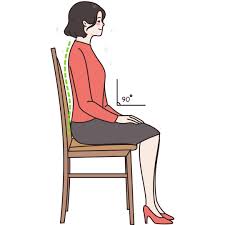

Text neck is the modern-day equivalent of having a permanent crick in your neck, thanks to our obsession with smartphones, tablets, and laptops.
With heads bowed and spines slouched over, millions of us unknowingly fall into the trap of bad posture daily.
But fear not!
The secret to correcting this painful issue might be simpler than you think: your chair.
Adjusting your chair properly can not only be the best forward head posture fix but also prevent future strain and discomfort.
In this article, we will explore how tweaking your sitting habits, selecting the right chair, and adopting better posture can get your neck back in shape, without giving up your devices.
Article Index:
- What Is Text Neck and Why Does It Hurt So Much?
- How Proper Chair Adjustment Can Prevent Text Neck
- The Right Chair for You: From Lumbar Support to High Back
- Neutral Posture Chair Adjustments for Long-Term Comfort
- How to Use a Kneeling Chair to Combat Text Neck
- Real-Life Example: How Amy Fixed Her Text Neck by Adjusting Her Chair
- Conclusion: A Healthier Neck Starts with Your Chair
What Is Text Neck and Why Does It Hurt So Much?
Let us start with the basics.
Text neck refers to the repetitive strain injury that occurs from constantly looking down at your phone or other devices.
According to Dr. Kenneth Hansraj, a spinal and orthopedic surgeon, looking down at a smartphone can put up to 60 pounds of pressure on your neck.
This unnatural position can lead to muscle strain, headaches, and even permanent damage if left unchecked.
Your head weighs around 10-12 pounds when held in a neutral, upright position. The further forward it tilts, the more strain it puts on your neck and spine.
The result?
Chronic pain, stiffness, and even long-term postural issues.
How Proper Chair Adjustment Can Prevent Text Neck?
The easiest way to combat text neck is not throwing away your phone (who can do that?), but adjusting the chair you sit in.
Ergonomics—the science of designing the workplace to fit the individual—can make all the difference when it comes to your neck posture.
By positioning your chair and screen correctly, you can stop hunching forward and start giving your spine a break.
Proper office chair adjustment is key. Here’s what to do:
- Height matters: Your chair should be adjusted so that your feet rest flat on the floor and your knees are at a 90-degree angle. Too high or too low, and you’ll find yourself craning your neck forward.
- Screen alignment: Your computer or device screen should be at eye level. This prevents you from leaning forward or tilting your head down, which exacerbates text neck.
- Lumbar support: Chairs with good lower back support, like a cross-legged chair with lumbar support, can help you maintain a neutral spine position. If your chair doesn’t have adequate support, consider adding a lumbar pillow.
A 2012 study in the Journal of Physical Therapy Science confirmed that proper ergonomic adjustments can significantly reduce musculoskeletal discomfort, particularly in the neck and shoulders.
The Right Chair for You: From Lumbar Support to High Back
Not all chairs are created equal, and finding the right one can make a huge difference in preventing and fixing text neck.
Here are some features to look for:
- High back posture chair: These chairs support your entire back and head, encouraging you to sit upright rather than slouch. A high-back chair helps distribute the weight of your head evenly across your spine, reducing neck strain.
- Cross-legged chair with lumbar support: If you are someone who likes to change positions often, a cross-legged chair with built-in lumbar support can keep your spine aligned while allowing for flexibility in movement.
- Pneumatic ergonomic kneeling chair: This unconventional option tilts your pelvis forward, promoting a more upright posture. While it might seem odd at first, a kneeling chair desk height is designed to engage your core and prevent the slumping that causes text neck.
Real-world example: John, a 35-year-old office worker, struggled with text neck for years.
After switching to a high back posture chair, he noticed a significant improvement in his neck pain.
The chair’s headrest kept his spine aligned, and the lumbar support helped him maintain good posture for long workdays.
Neutral Posture Chair Adjustments for Long-Term Comfort
Sitting in a neutral posture—where your spine maintains its natural curve—is the best way to avoid straining your neck.
Whether you’re sitting for work or scrolling through social media, adjusting your chair to fit this posture can save you from future neck pain.
Neutral posture chair adjustments should include:
- Seat height: Ensure your hips are slightly higher than your knees. This promotes a neutral spine and prevents slouching.
- Backrest tilt: Your chair should support a slight recline (about 100-110 degrees) to reduce pressure on your lower back and neck. Keeping the backrest too straight can force you to lean forward, exacerbating neck strain.
- Armrest positioning: Adjust your armrests so that your elbows are at a 90-degree angle, preventing your shoulders from hunching up toward your ears—a common culprit for neck stiffness.
A 2015 study published in Workplace Health & Safety found that workers who made ergonomic adjustments, especially to their chair height and backrest, reported significantly less discomfort in their neck and back.
How to Use a Kneeling Chair to Combat Text Neck?
Now, let’s talk about a less conventional option: the kneeling chair.
A kneeling chair desk height setup forces you into a more upright position by encouraging a forward tilt of the pelvis.
This opens up your hips and aligns your spine, reducing neck strain. However, using a kneeling chair requires some practice and adjustment to find your kneeling chair height sweet spot.
Real-life example: Sarah, a graphic designer, switched to a pneumatic ergonomic kneeling chair after months of suffering from text neck.
At first, the new chair felt uncomfortable, but after adjusting it to the correct height, she noticed her posture improving.
Within a few weeks, her neck pain had diminished, and she felt more energized throughout her workday.
Real-Life Example: How Amy Fixed Her Text Neck by Adjusting Her Chair?
Amy, a 28-year-old marketing manager, found herself constantly looking down at her laptop during meetings and phone calls.
After months of neck pain and headaches, she realized her chair and accompanying furniture was part of the problem.
Her previous office setup had her sitting too low, forcing her to crane her neck down toward the screen.
After learning about proper office chair adjustment, Amy made a few simple tweaks:
- She raised her chair so her knees were at a 90-degree angle.
- She positioned her screen at eye level using a laptop stand.
- She added a lumbar support cushion to her chair, promoting a neutral spine.
Within days, Amy noticed a significant reduction in her neck pain.
Now, instead of rubbing her neck at the end of the day, she leaves the office pain-free.
A Healthier Neck Starts with Your Chair
Let’s recap. Text neck is a real pain—literally. But the good news is, you do not have to live with it.
By adjusting your chair and adopting proper posture habits, you can significantly reduce strain on your neck and back.
From selecting the right high back posture chair to experimenting with a pneumatic ergonomic kneeling chair, your solution may be as simple as changing how you sit.
Remember, keeping your screen at eye level, ensuring your chair height is correct, and adding lumbar support are all key steps to fixing text neck.
So next time you feel that familiar twinge in your neck, do not reach for the painkillers—adjust your chair instead. Your spine will thank you!
References:

